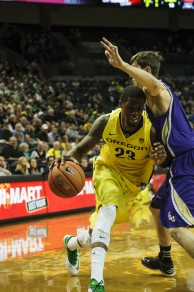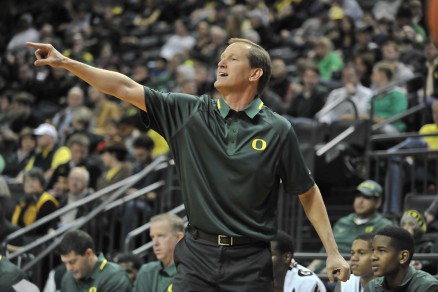Craig Strobeck
Dana Altman’s team just keeps getting better. Ten games in and they have yet to lose, and for the most part, have won convincingly with a 15.6 point average margin of victory. Coming off another stellar performance Tuesday night against UC Irvine, Oregon kept its unblemished record alive as they march toward the challenges of conference play. Here’s a quick look at what has helped them get to this point, and what is expected to hurt them going forward:
Efficient Guard Play
In what has become a regular occurrence, Altman made a big splash this off-season landing elite transfers Jason Calliste, Mike Moser, Elgin Cook and scoring leader Joespeh Young. Consider that these players are being added to a backcourt already featuring Dominic Artis, Pac-12 All-Freshman Damyean Dotson and Pac-12 tournament MVP Johnathan Loyd. Before the season there was speculation Altman would need to start four guards to accommodate the abundant talent.
Altman however, has opted for the standard lineup – three guards with Moser and Waverly Austin down low. All five guards are seeing regular minutes, thriving in Altman’s precise and successful rotations: averaging 89.3 points a contest, second best in the country. Not only are they scoring a lot, but they doing it efficiently. The team is shooting a combined 53.2% from the field, which ranks fourth best in Division 1.
Unlike your prototypical guards, Oregon’s attack the rim. Per the website Hoop-Math, the Ducks make 70.3% at the rim, 9.4% more then the D-1 average. Taking just under three quarters (74.5%) of his shots at the rim, slasher Elgin Cook leads the Ducks with an impressive 85.7% field goal percentage. Overall, Cook ranks fifth in the Pac-12 shooting a gaudy 63% from the field.
Oregon’s torrid start to the season begins and ends with the play of their guards. Six players have double-digit scoring averages, and all six are guards! Five of the six are shooting 50% or better from the field furthering the theme of efficiency.
Frontcourt Yet To Be Tested
While the guards are getting all the praise, we cannot forget about the big bodies inside. After losing Tony Woods and rebounding machine Arsalan Kazemi, it has been hard to replace their impact and production. Waverly, a starter, is nearly non- existent in Altman’s offense, attempting only 22 shots and converting half of those in an average 13.9 minutes per game. His counter part, Richard Amardi, has done a nice job coming off the bench but there is still a lack of production from the big men. Both average under seven points a contest and neither lead the team in rebounds.
So far, the frontcourt has yet to be truly tested. Heading into conference play however, they will meet skilled centers that are physical and dominate the paint. Altman’s game plan may have to be revised, as his big men might need to see the court more than usual in order to defend opposing centers.
Altman and the Ducks have looked stellar so far. With the recent return of Artis and Ben Carter, and possibly recently cleared Freshman Jordan Bell, Oregon will have even more depth to work with. However, it is highly likely that to have success in a physical Pac-12 conference, Waverly and Amardi must step up. If not, teams will feast on the Ducks inside. We will know soon how the Ducks and Altman respond to the upgraded challenges of conference play, a conference that currently features three teams ranked in the Top 20.
Related Articles:
Chip Kelly Update: Everything's Good Again ...
Chip Kelly Update: Wailing and Gnashing of Teeth
Shock and Awe -- The Oregon Ducks' Football Hangover Effect
Despite Lopsided Score, Georgia State "Never Stopped Believing"
Hope Springs Eternal for Ducks
Incompetent Pac-12 Officials: How Do You Miss ALL of THIS?
Luc Hancock is a senior at the University of Oregon majoring in Public Relations. He is from San Francisco, California and loves all sports, with his favorites being baseball and basketball. Luc is a die hard bay area sports fan and has been spoiled with the recent success of his teams in the past year. He did not become a Ducks fan until he came to the university 3 years ago, but now accepts them along with his other favorite teams. When Luc is not writing, thinking, or playing sports, he enjoys watching Seinfeld reruns and hanging out with friends. Luc is open to feed back. Follow him on twitter @luchancock


